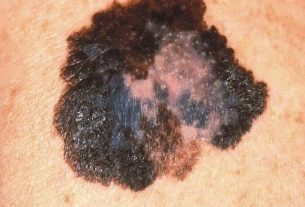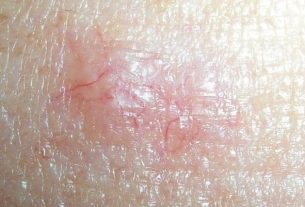Fibroadenoma is a benign nodule in the breast that can appear in women under 30 years of age. Fibroadenoma corresponds to a hard lump in the breast, which does not cause pain or discomfort, and which is similar to a marble.
Generally, breast fibroadenoma is up to 3 cm in size and is easily identified during menstruation or pregnancy due to the increased production of hormones that increase its size.
Breast fibroadenoma does not turn into cancer, but, depending on the type, it may slightly increase the chances of developing breast cancer in the future. Therefore, it is important that women are regularly monitored by a gynecologist and/or mastologist.

Fibroadenoma symptoms
The main sign of breast fibroadenoma is the appearance of a nodule that:
- It has a round shape;
- It is hard or rubbery in consistency;
- Does not cause pain or discomfort.
Any other symptom is extremely rare, although some women may report slight discomfort in the breast in the days immediately before menstruation.
Don’t ignore your symptoms!
Can fibroadenoma turn into cancer?
In most cases, fibroadenoma and breast cancer are not related, as fibroadenoma is a benign tumor, unlike cancer, which is a malignant tumor. However, according to some studies, women who have complex fibroadenoma may have up to 50% more chances of developing breast cancer in the future.
This means that having a fibroadenoma does not mean that you will get breast cancer, since even women who do not have any type of fibroadenoma are also at risk of getting cancer. Therefore, ideally, all women, with or without fibroadenoma, should perform breast self-examination regularly to identify changes in the breast, as well as undergo mammography at least once every 2 years to identify early signs of cancer.
Possible causes of fibroadenoma
Breast fibroadenoma does not yet have a specific cause, however, it is possible that it appears due to an increased sensitivity of the body to the hormone estrogen. Therefore, women who are taking contraceptives appear to have a greater risk of developing fibroadenoma, especially if they start using them before the age of 20.
How to confirm the diagnosis
The diagnosis of fibroadenoma in the breast is normally made by a breast specialist with the help of diagnostic tests, such as mammography and breast ultrasound.
A mammogram generally indicates whether there are any changes in the breast, the degree of the lesion in the breast and estimates the possibility of it being cancer, through the BIRADS system, which can be:
- Birads 0: this type of result means that the exam has no diagnostic conclusion or is even incomplete, generally due to low quality image, or when there is doubt as to whether or not a lesion exists, making it necessary to carry out other complementary exams, such as ultrasound of breast;
- Birads 1: indicates that the exam is normal or negative, showing no changes, in which case it is recommended to undergo annual medical monitoring;
- Birads 2: indicates that benign lesions were found in the breast, which could be fibroadenoma, breast cyst or calcifications, for example, and annual medical follow-up is generally recommended;
- Birads 3: indicates that changes were found in the examination, probably benign, and the doctor generally recommends that a mammogram be performed every 6 months to monitor the lesion;
- Birads 4: indicates that there is a suspicion of a malignant lesion in the breast, and, in this case, a biopsy is performed to confirm the diagnosis;
- Birads 5: indicates that changes were found and that there is a lesion, which is possibly cancer, requiring a biopsy to confirm the diagnosis;
- Birads 6: This type of result is given to women who have already been diagnosed with breast cancer and are undergoing a mammogram to monitor their cancer treatment.
These tests must be interpreted by the doctor, to confirm the diagnosis and provide the most appropriate treatment according to the type of injury.
Types of fibroadenoma
There are different types of breast fibroadenoma:
- Fibroadenoma simples: is normally less than 3 cm, contains only one type of cells and does not increase the risk of cancer;
- Complex fibroadenoma: contains more than one type of cells and very slightly increases the risk of breast cancer.
Furthermore, the doctor may also mention that the fibroadenoma is juvenile or giant, which means it is more than 5 cm, which is more common after pregnancy or when taking hormone replacement therapy.
How the treatment is carried out
Treatment for breast fibroadenoma must be guided by a mastologist, but is normally done only with annual mammograms and ultrasounds to monitor the development of the nodule, as it can disappear on its own after menopause.
However, if your doctor suspects that the nodule may actually be cancer rather than a fibroadenoma, he or she may recommend surgery to remove the fibroadenoma and perform a biopsy to confirm the diagnosis.
After surgery for breast fibroadenoma, the nodule may reappear and, therefore, surgery should only be used in cases of suspected breast cancer, as it is not a cure for breast fibroadenoma.
Bibliography
- MAGNY, SJ; SHIKHMAN, R.; KEPPKE, AL IN: STATPEARLS (INTERNET). TREASURE ISLAND (FL): STATPEARLS PUBLISHING. Breast Imaging Reporting and Data System (BIRADS). 2021. Available at: <https://www.ncbi.nlm.nih.gov/books/NBK459169/>. Accessed on May 30, 2022
- BREAST CANCER CARE. Fibroadenoma. Disponível em: <https://www.breastcancercare.org.uk/information-support/have-i-got-breast-cancer/benign-breast-conditions/fibroadenoma>. Acesso em 08 ago 2019
- MEDICAL NEWS TODAY. What to know about fibroadenomas of the breast. Available at: <https://www.medicalnewstoday.com/articles/323951.php>. Accessed on Aug 8, 2019
- BREAST CANCER ORG. Fibroadenoma. Available at: <https://www.breastcancer.org/symptoms/benign/fibroadenoma>. Accessed on Aug 8, 2019

Sign up for our newsletter and stay up to date with exclusive news
that can transform your routine!
Warning: Undefined array key "title" in /home/storelat/public_html/wp-content/plugins/link-whisper-premium/templates/frontend/related-posts.php on line 12
Warning: Undefined array key "title_tag" in /home/storelat/public_html/wp-content/plugins/link-whisper-premium/templates/frontend/related-posts.php on line 13



